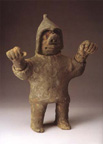

386-534 CE
Northern Wei period, China
Painted potter
Heights: 39 cm, 43.5 cm
Image courtesy of the Inner Mongolia Museum, Huhehaote (copyright reserved)
The influence of Chinese culture on the Tuoba ruling class was quite profound. As was the case with many of the non-native rulers who ruled China during different periods of its history, the Tuoba Xianbei enthusiastically adopted Chinese dress, language, court culture and religion. At one point, the ruler Xiawendi even went so far as to force his Xianbei subjects to adopt Chinese surnames.1
The upper classes also adopted Chinese burial practices. Northern Wei era tombs included numerous treasures and material goods to be carried into the afterlife with the deceased. Also found in Xianbei tombs are mingqi, figurines made of wood or pottery modeled as variously as entertainers, soldiers and guardians, or sometimes tradesmen, which would austensibly offer their services in the world beyond to the occupants of the tomb.
These two mingqi figures are soldiers, a common enough fixture in Chinese tombs from as early on as the Han period. On closer inspection, however, one notices that these guardians are not human. Their faces are painted with a red pigment, their noses are large and bulbous, and in the case of the lower example, large fangs protrude from the figure's mouth. Their hands are partly open and in a position that indicates they once held objects now lost, possibly weapons. The hands and heads of the figures are removable, and the bodies virtually identical, which may indicate these figures were semi-massed produced in smaller pieces, and assembled afterwards. By creating separate heads and hands (the most expressive parts of the figures), the craftsmen were able to create a wide variety of types with individualized features using the least amount of effort.
(1) Adam T. Kessler, Empires Beyond the Great Wall: The Heritage of Genghis Khan (Los Angeles: Natural History Museum of Los Angeles County, 1993), p. 86.